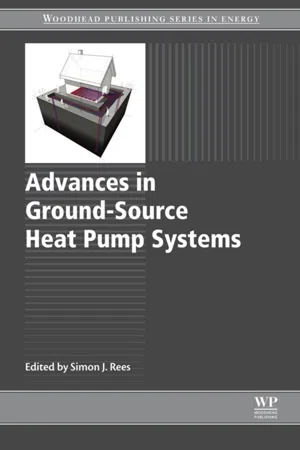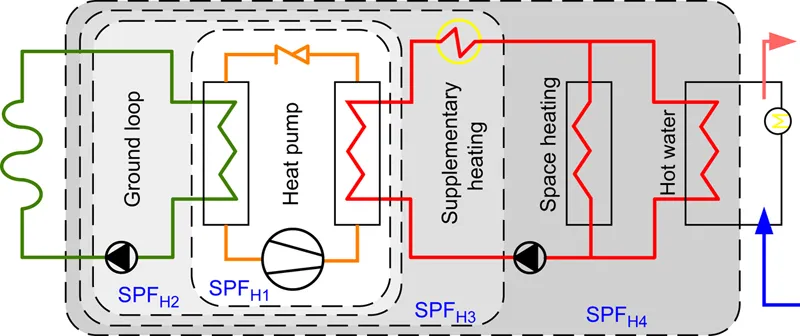Heat pumps are a form of heat engine that uses mechanical work to transfer heat from a low temperature source to a higher temperature sink. There are a wide range of applications of heat pumps but in this context we are concerned with transferring heat between buildings and the external environment – either rejecting heat to the environment and cooling the building or extracting heat and heating the building. Although various forms of thermodynamic cycle can be used to move heat between source and sink, the predominant form is based on the vapour–compression cycle in which a refrigerant gas is evaporated, compressed and condensed in turn to transfer heat. The principle components in the cycle are shown in Fig. 1.1. The state of the refrigerant throughout the cycle is well illustrated in an enthalpy–pressure diagram such as that on the right of this figure. The enthalpy changes in the condenser and evaporator indicate the heat transfer rate per unit mass of refrigerant flowing. Chapter ‘New trends and developments in ground-source heat pumps’ provides an in-depth review of refrigeration technology applied in heat pumps adapted for ground-coupled applications.
The prime reason for the interest in using heat pumps to provide heating and cooling is that it takes less work to move heat from source to sink than it does to convert primary energy into heat. In other words, the power required is noticeably less than the heating or cooling delivered. This effect is quantified in classical thermodynamics by the coefficient of performance (COP). If
is the quantity of heat delivered and
W is the work required, then
. Classical thermodynamics also tells us that this has a theoretical maximum value (Carnot efficiency) limited by the absolute temperature of the source
and sink
so that,
in heating
mode. This implies that higher efficiencies can be achieved if the source and sink temperature are close together – as is generally the case when considering buildings and their surrounding environment. It will be shown later (
Section 1.1.3) that conditions are particularly favourable where the heat source takes the form of a geothermal heat exchanger.
The relatively high COP values that are achievable with GSHPs mean that the energy consumed is effectively leveraged so that much higher quantities of heating and cooling are delivered. This effect means that even with electricity derived from thermal power generation, where a lot of primary energy becomes waste heat at the power station, the heat exchanged with the building is greater than the primary energy consumed. This is illustrated in the upper Sankey diagram in Fig. 1.2. If one considers renewable energy sources (RES) of electricity (eg, wind power), where there is no wastage of primary energy at the source, the heat pump effect is even more significant and the carbon emissions associated with the heating and cooling demand can approach zero. RES are a limited resource and so when one considers provision of heating demands, a heat pump can be seen to be a valuable mechanism to leverage the available generation capacity (resistance heating being a poor use of renewable electricity in comparison). This is indicated in the lower Sankey diagram in Fig. 1.2.













